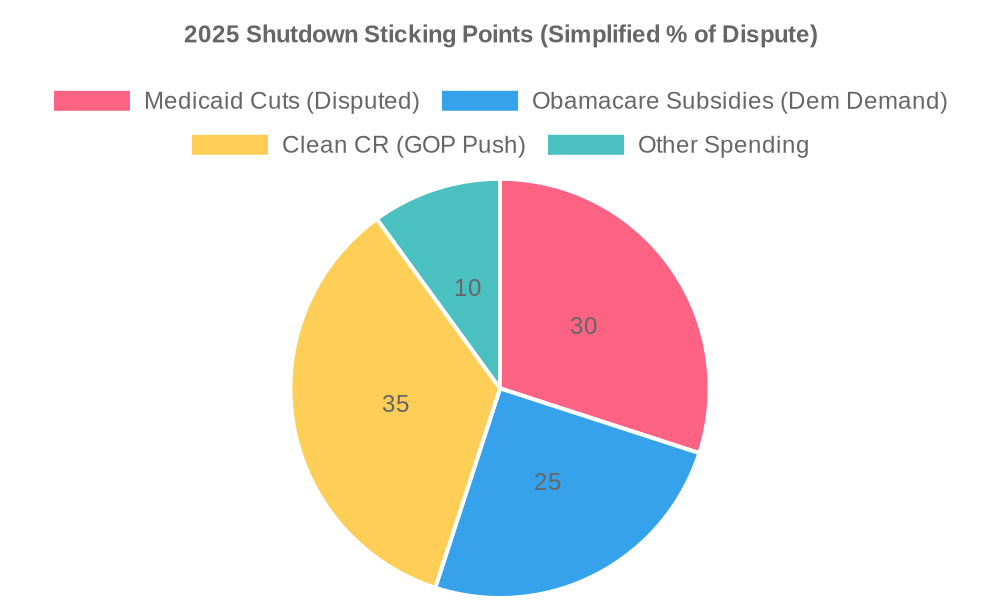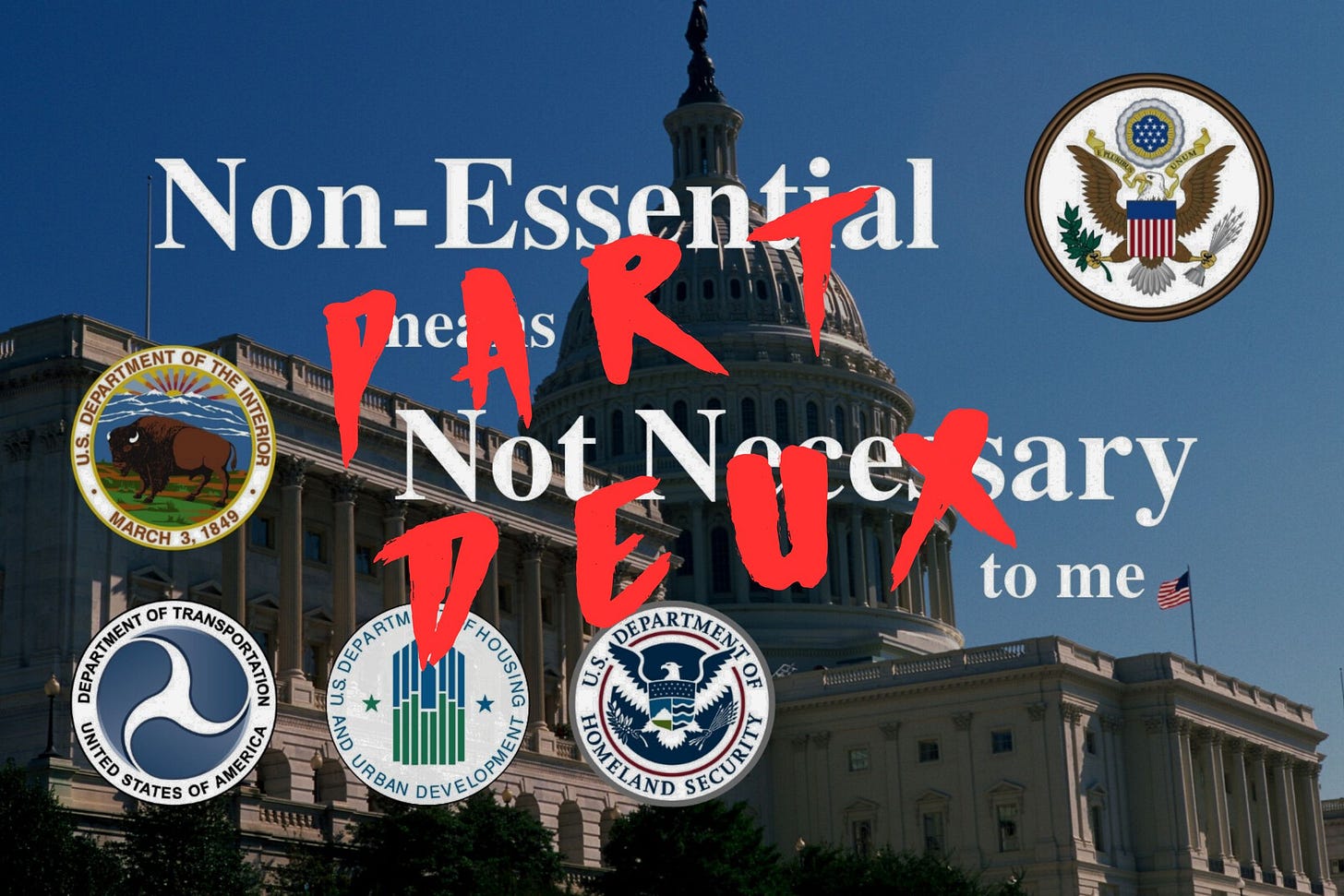Non-Essential Means Not Necessary: The 2025 Shutdown Remix
The government is shut down... again... but let’s not waste it. Use this pause to question: What is essential?
It’s January 2019, and I’m staring at my TV screen, half-watching the news while dealing with an upset kid. The government shutdown drags on—day 25, to be exact—and pundits are wailing about furloughed workers, closed parks, and the end of civilization as we know it. I grab my laptop, and draft a blog post titled “Non-Essential Means Not Necessary,” and hit publish. In it, I argue that if nearly half of federal employees are suddenly “non-essential,” maybe the whole bloated beast isn’t as vital as we think. Little did I know, six years later, I’d be dusting off that same keyboard for Part Deux.
Fast forward to today, October 1, 2025. Last night, at the stroke of midnight, the US Federal Government slammed the brakes—our first shutdown of Trump’s 2nd term, and the first since that epic 35-day standoff back in 2018-19. Over dinner, my husband Joe and I explained it to the kids like this: “Politicians in Washington often fight over money like brothers fighting over who can throw the football the furthest, and everyone else has to sit in time-out.” Both kids looked at me with confused expressions.
This isn’t just déjà vu; it’s a full-on rerun with higher stakes. Back in 2019, the fight was over border walls and budgets. Today? It’s healthcare showdowns, with Democrats digging in on Obamacare subsidies and Medicaid reversals. As a lifelong Type 1 diabetic who’s seen my share of medical bureaucracy, it hits close to home. But here’s the hook: Every shutdown is a rude awakening, a forced audit of what The Federal Government really needs versus what we’ve all been conditioned to think is indispensable. If It were up to me, I would use this mess not to panic, but to prune.
Unpacking the Chaos and History
Shutdowns Aren’t New, But the Patterns Are Predictable
Government shutdowns aren’t some modern plague; they’ve been a bipartisan headache since the 1970s, with 20-plus episodes totaling over 100 days of drama. The big ones? 1995-96 (21 days, over budgets and debt ceilings), 2013 (16 days, Obamacare funding), and that 2018-19 marathon (35 days, immigration). Each time, the sky doesn’t fall—Social Security checks keep coming, the military stays on duty—but the rhetoric increases and the “end of days” is predicated by at least one side.
What ties them together? Partisan trench warfare over spending. Republicans cry “fiscal responsibility”; Democrats shout “protect the vulnerable.” Rinse, repeat. By 2025, with national debt clocking in at $36 trillion (that’s $107,000 per citizen, if you’re keeping score at home), you’d think we’d learn. But nope—here we are, staring down another one. As Yogi Berra might say, it’s déjà vu all over again.
What’s Fueling This 2025 Fire?
If you blinked last week, you missed the spark. It all traces back to July 2025, when President Trump signed a massive tax-and-spending bill that sliced $500 billion from Medicaid over the next decade, funneling those savings into tax cuts and “pro-growth” initiatives. Democrats howled “assault on healthcare,” warning millions would lose coverage. Fast-forward to September: House Republicans passed a clean continuing resolution (CR)—basically, a “pay the bills and fight later” bill—to keep things humming through November 21.
Enter Senate Democrats, who filibustered it on September 27, slapping on demands for Obamacare subsidy extensions and Medicaid cut reversals. A White House sit-down collapsed two days later, with Trump posting a viral video lampooning Senate Majority Leader Schumer and House Minority Leader Jeffries as budget hostage-takers. Betting markets pegged the shutdown odds at 86% by yesterday morning—prophetic, as the Senate vote flopped without seven Democratic crossovers.
Why now? Timing’s everything. With midterms looming in 2026, Dems see healthcare as their golden ticket—polls show it’s a winner for sympathy votes. Republicans, led by Trump and Vice President Vance, frame it as Democrats holding the military and feds hostage for “left-wing giveaways.” Vance called the demands “unserious” on a podcast last week, while Trump floated “permanent firings” for “swamp” workers. Both sides are betting the public will blame the other.
To visualize the standoff, here’s the budget battlefield as a pie chart:

The Human (and Economic) Toll: Who’s Hurting, and Why It Proves My Point
Short answer: About 900,000 federal workers face furloughs, national parks shutter (sorry, fall foliage fans), NIH research pauses, IRS audits slow, and food programs like WIC glitch for 7 million families. Essential stuff? Military, Social Security, border patrol, air traffic control—they chug along. But the “non-essentials”—47.5% of the workforce, echoing my 2019 post—get pink-slipped without pay.
Economically? October jobs data delays could spook markets already jittery from inflation whispers. Past shutdowns shaved 0.2-0.6% off GDP; this one’s projected at $1.5 billion daily hit. Yet, here’s the irony: During the 2018-19 shutdown, small businesses boomed in D.C. as furloughed feds turned to gig work. One barista I read about quipped, “Finally, tips from people who know bureaucracy’s a scam.”
Anecdote time: Back in 2019, a buddy in Atlanta—a contractor for HUD—got furloughed for weeks. He used the downtime to launch a side hustle flipping houses. “Best thing that happened,” he said over beers. “Forced me to realize the government’s middleman fee ain’t worth it.” Today, with remote work normalized post-COVID, expect more of that: Furloughed feds Uber-ing, Etsy-ing, or just questioning why we’re funding 95% “non-essential” HUD staff who mostly push paper on mortgages the government should never be involved with in the first place.
From Border Walls to Healthcare Walls, the More Things Change...
Compare 2019 to now: Then, it was walls (literal and figurative) over immigration. Now, it’s walls over welfare—Medicaid as the new Maginot Line. But the root? Same old addiction to spending. Federal outlays hit $6.8 trillion last year; we’re borrowing 20 cents on every dollar. Trump’s July bill aimed to trim fat, but Dems see it as a Trojan horse for austerity.
Trump tweeted yesterday, “Democrats want to hold America hostage for their radical healthcare agenda. NOT ON MY WATCH!” Meanwhile, Schumer fired back: “This is cruelty disguised as conservatism—millions will suffer.” Balanced? Both have kernels of truth. Cuts hurt the vulnerable short-term; endless subsidies balloon debt long-term. Data from the CBO shows Medicaid expansions added 15 million enrollees since 2010, but at $700 billion annual cost. Solution-oriented? Tie reforms to pilots: State-level experiments in block grants, like Indiana’s healthy Indiana plan, which boosted employment without skimping care.
If shutdowns were a band, it’d be The Who—same old song, different year, and the audience (us taxpayers) just wants the encore to end.
My unCommon Sense
Shutdowns aren’t failures; they’re features. They expose the emperor’s new clothes—or in this case, the non-essential’s naked bureaucracy. If 900,000 workers can vanish overnight and the sun still rises, why are we propping up departments like HUD (95% non-essential) or the Executive Office (61%)? The Federal Government doesn’t create value; it redistributes it, mostly inefficiently.
Hey... Voters!! We elect these spendthrifts, then act shocked at the bill. As a dad, I teach my boys: Choices have trade offs, benefits, and consequences. Want parks open? Pony up via user fees, not taxes. Healthcare? Empower states and markets—vouchers for subsidies, competition for costs, and move government regulation out to encourage more of a free market for the consumers benefit. My diabetes care thrives on choice: I pick my insulin, but not my doc, and not my plan (“Thanks” to Gov’t).
This shutdown stings more as a self employed business owner, with kids in tow. But it’s a teachable moment. “See, boys? Even grown-ups screw things up. Fix it by owning it.” Solution: Mandate a post-shutdown “efficiency audit”—slash 10% across non-essentials, privatize TSA (remember those long lines?), devolve housing to locals. Trump could lead: Use leverage for real reform, not tweets. Dems? Drop the riders; govern like adults.
As the shutdown ticks into day one, I’m optimistic. History shows they end—usually with a CR and grudges. But let’s not waste it. Use this pause to question: What is essential? For me, it’s family, freedom, and fiscal sanity. Families on WIC? Heartbreaking—push targeted aid. Furloughed workers? Gig economy awaits. Broader? A leaner government frees us for real prosperity.
What about you? Ever furloughed? Suffered from a past shutdown? Or got a wild idea to fix D.C.? Hit reply or shoot me an email at dan@thrailkill.us—we’ll grab coffee (or a virtual beer) and hash it. In a world of shutdowns, conversation’s the one service that never furloughs.
Have a good one,
Dan



